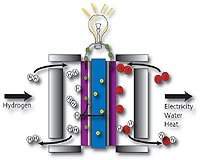 |
Houston TX (SPX) May 19, 2009 If one University of Houston professor has his way, the inexpensive plastic now used to manufacture CDs and DVDs will one day soon be put to use in improving the integrity of electronics in aircraft, computers and iPhones. Thanks to a pair of grants from the U.S. Air Force, Shay Curran, associate professor of physics at UH, and his research team have demonstrated ultra-high electrical conductive properties in plastics, called polycarbonates, by mixing them with just the right amount and type of carbon nanotubes. The findings are chronicled in a paper titled "Electrical Transport Measurements of Highly Conductive Carbon Nanotube/Poly(bisphenol A carbonate) Composite," appearing in a recent issue of the Journal of Applied Physics, the archival publication of the American Institute of Physics for significant new results in the field. Curran, who initially began this form of research a decade ago at Trinity College Dublin, started to look at high-conductive plastics in a slightly different manner. Curran's team has come up with a strategy to achieve higher conductivities using carbon nanotubes in plastic hosts than what has been currently achieved. By combining nanotubes with polycarbonates, Curran's group was able to reach a milestone of creating nanocomposites with ultra-high conductive properties. "While its mechanical and optical properties are very good, polycarbonate is a non-conductive plastic. That means its ability to carry an electrical charge is as good as a tree, which is pretty awful," Curran said. "Imagine that this remarkable plastic can now not only have good optical and mechanical properties, but also good electrical characteristics. By being able to tailor the amount of nanotubes we can add to the composite, we also can change it from the conductivity of silicon to a few orders below that achieved by metals." Making this very inexpensive plastic highly conductive could benefit electronics in everything from military aircraft to personal computers. Computer failure, for instance, results from the build up of thermal and electrical charges, so developing these polymer nanotube composites into an antistatic coating or to provide a shield against electromagnetic interference would increase the lifespan of computing devices, ranging from PCs to PDAs. The next step of this research is to develop ink formulations to paint these polycarbonate nanocomposites onto various electrical components. Normally, metal plates are used to dissipate electrical charge, so it's not surprising that the availability of a paintable ink would be particularly appealing to the Air Force for its lightweight properties, resulting in lighter aircraft that guzzle less gas. Another key component of this latest research is that pristine nanotubes disbursed in this polycarbonate were found to possess an even higher conductivity than acid-treated carbon nanotubes. Traditionally, the tubes are sonicated, or treated with acid, to clean them and remove soot to get a higher conductivity. This, however, damages the tubes and exposes them to defects. Instead, Curran and his group were able to centrifuge, or swirl, them. This takes a little longer, but increases the potential to have higher conductivities. He attributes this to the incredibly clean samples of carbon nanotubes obtained from fellow collaborator David Carroll in the physics department at Wake Forest University. In addition to Curran and Carroll, the team behind these remarkable findings includes Donald Birx, professor of electrical engineering and vice president for research at UH, two of Curran's former post-doctoral students, Jamal Talla and Donghui Zhang, and a current Curran student, Sampath Dias. Coincidentally, Curran's former thesis supervisor Werner Blau and his group in the department of physics at Trinity College Dublin have come out with similar findings recently in the journal ACS Nano. Both groups really have been pushing hard in the area of polymer nanotube composites during the course of the last decade. Curran said his group at UH achieved the highest conductivity levels so far, but also is encouraged by Blau's success and said repeating these types of outcomes will open doors for even higher values. "While these are phenomenal results, finding these unusual highly conductive properties has not even begun to scratch the surface," Curran said. "There is hard science behind it, so developing it further will require significant investment. And we are very thankful to the Air Force for giving us this auspicious start." Share This Article With Planet Earth
Related Links University of Houston Powering The World in the 21st Century at Energy-Daily.com
 New Fuel Cell Catalyst Uses Two Metals
New Fuel Cell Catalyst Uses Two MetalsSt. Louis MO (SPX) May 19, 2009 Material scientists at Washington University in St. Louis have developed a technique for a bimetallic fuel cell catalyst that is efficient, robust and two to five times more effective than commercial catalysts. The novel technique eventually will enable a cost effective fuel cell technology, which has been waiting in the wings for decades, and should give a boost for cleaner use of fuels ... read more |
|
| The content herein, unless otherwise known to be public domain, are Copyright 1995-2009 - SpaceDaily. AFP and UPI Wire Stories are copyright Agence France-Presse and United Press International. ESA Portal Reports are copyright European Space Agency. All NASA sourced material is public domain. Additional copyrights may apply in whole or part to other bona fide parties. Advertising does not imply endorsement,agreement or approval of any opinions, statements or information provided by SpaceDaily on any Web page published or hosted by SpaceDaily. Privacy Statement |